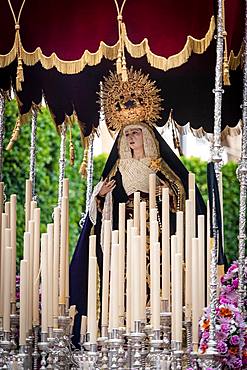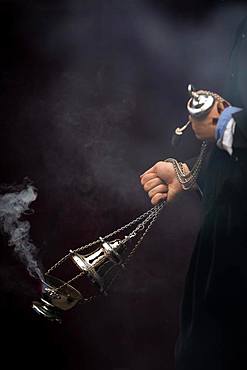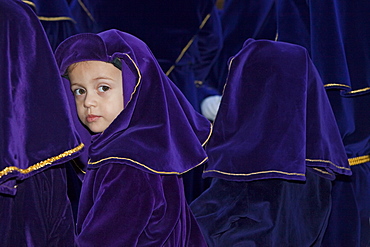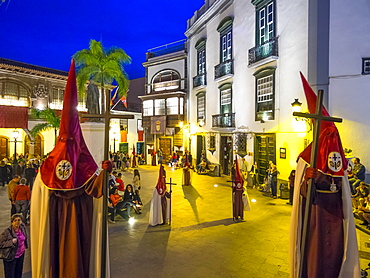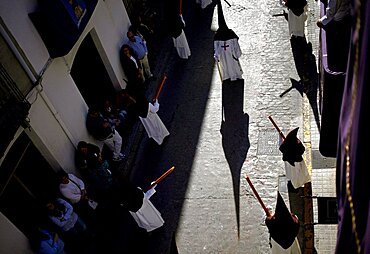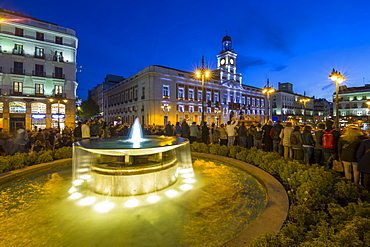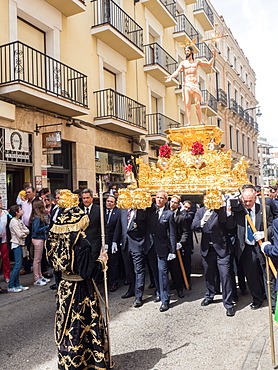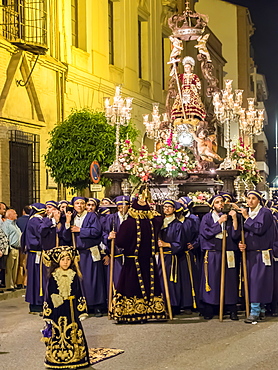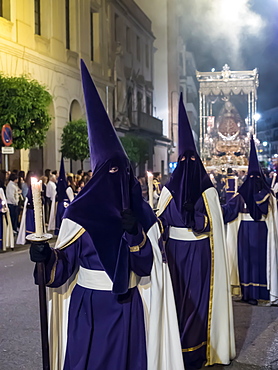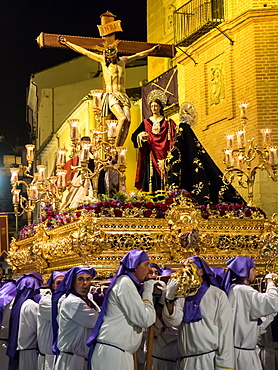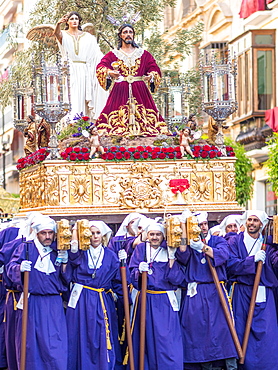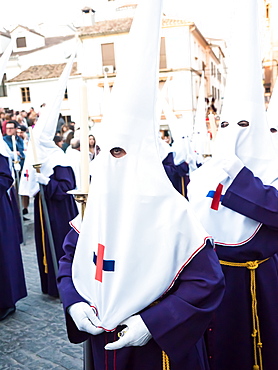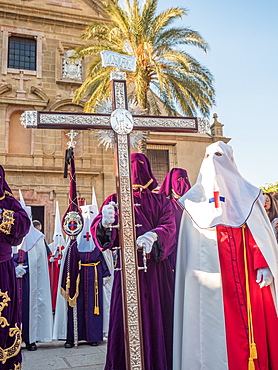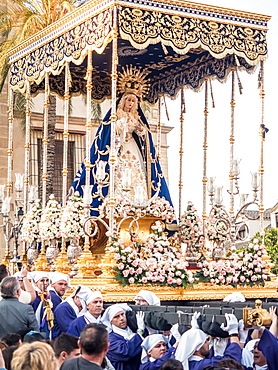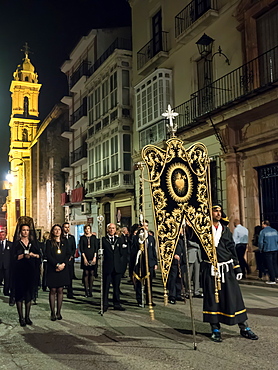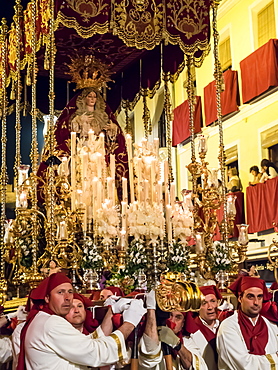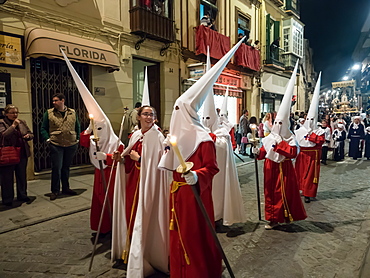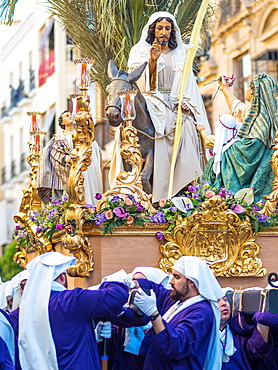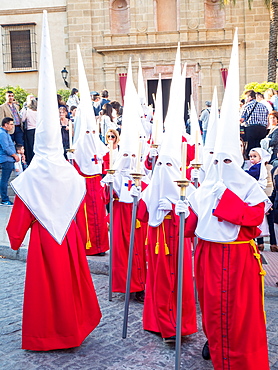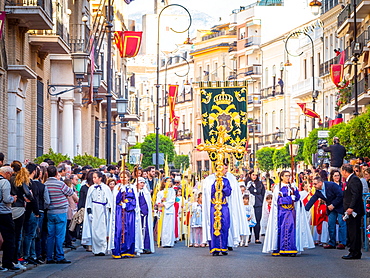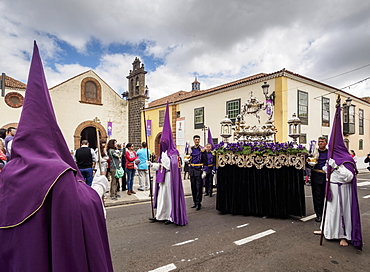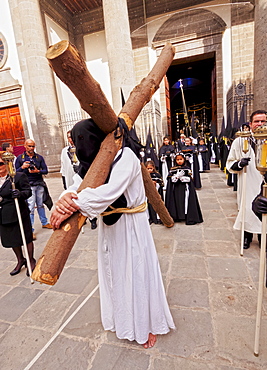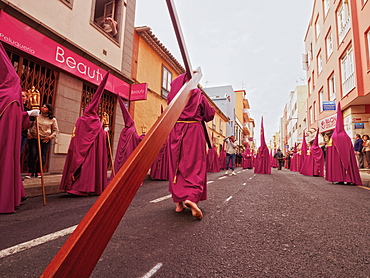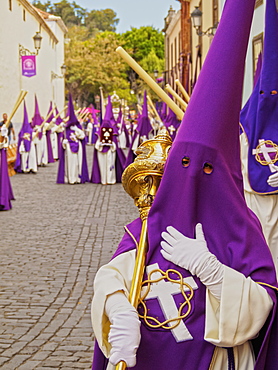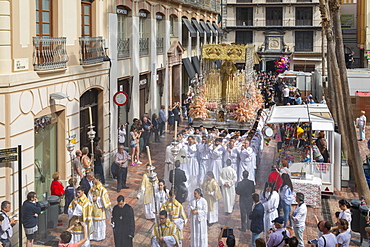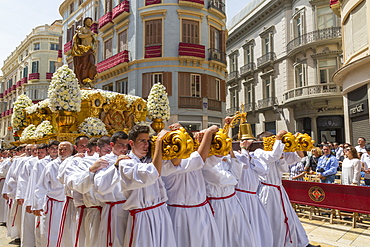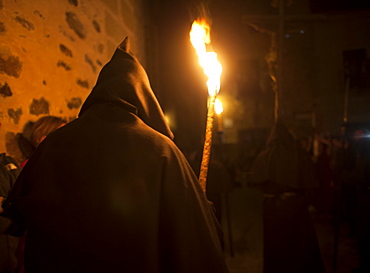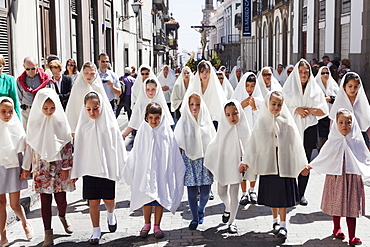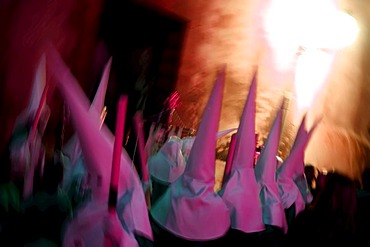Recent searches
Loading...
1350-6046 - Bishop blessing the palms,mass,Palm Sunday.Interior of Basilica Sagrada Familia, Barcelona, Catalonia, Spain
1350-2688 - Verges, a small town in the Northeast of Catalonia (Spain), during Easter celebrates the Procession of Verges with skeletons dancing on the sound of a drum, Roman soldiers, known as the 'Manages', and a representation of the life and crucifixion of Jesus Christ. The Procession features the Dance of Death, a tradition from the Middle Age associated with epidemics and plagues and the only one remaining in Spain Ten skeletons dance to the beat of a drum to remember that no one is exempt of death. The backdrop of the medieval walls and towers of Verges is key to this macabre staging.
1350-2693 - Verges, a small town in the Northeast of Catalonia (Spain), during Easter celebrates the Procession of Verges with skeletons dancing on the sound of a drum, Roman soldiers, known as the 'Manages', and a representation of the life and crucifixion of Jesus Christ. The Procession features the Dance of Death, a tradition from the Middle Age associated with epidemics and plagues and the only one remaining in Spain Ten skeletons dance to the beat of a drum to remember that no one is exempt of death. The backdrop of the medieval walls and towers of Verges is key to this macabre staging.
1350-2692 - Verges, a small town in the Northeast of Catalonia (Spain), during Easter celebrates the Procession of Verges with skeletons dancing on the sound of a drum, Roman soldiers, known as the 'Manages', and a representation of the life and crucifixion of Jesus Christ. The Procession features the Dance of Death, a tradition from the Middle Age associated with epidemics and plagues and the only one remaining in Spain Ten skeletons dance to the beat of a drum to remember that no one is exempt of death. The backdrop of the medieval walls and towers of Verges is key to this macabre staging.
1350-2695 - Verges, a small town in the Northeast of Catalonia (Spain), during Easter celebrates the Procession of Verges with skeletons dancing on the sound of a drum, Roman soldiers, known as the 'Manages', and a representation of the life and crucifixion of Jesus Christ. The Procession features the Dance of Death, a tradition from the Middle Age associated with epidemics and plagues and the only one remaining in Spain Ten skeletons dance to the beat of a drum to remember that no one is exempt of death. The backdrop of the medieval walls and towers of Verges is key to this macabre staging.
1350-2690 - Verges, a small town in the Northeast of Catalonia (Spain), during Easter celebrates the Procession of Verges with skeletons dancing on the sound of a drum, Roman soldiers, known as the 'Manages', and a representation of the life and crucifixion of Jesus Christ. The Procession features the Dance of Death, a tradition from the Middle Age associated with epidemics and plagues and the only one remaining in Spain Ten skeletons dance to the beat of a drum to remember that no one is exempt of death. The backdrop of the medieval walls and towers of Verges is key to this macabre staging.
1350-2691 - Verges, a small town in the Northeast of Catalonia (Spain), during Easter celebrates the Procession of Verges with skeletons dancing on the sound of a drum, Roman soldiers, known as the 'Manages', and a representation of the life and crucifixion of Jesus Christ. The Procession features the Dance of Death, a tradition from the Middle Age associated with epidemics and plagues and the only one remaining in Spain Ten skeletons dance to the beat of a drum to remember that no one is exempt of death. The backdrop of the medieval walls and towers of Verges is key to this macabre staging.
1350-2687 - Verges, a small town in the Northeast of Catalonia (Spain), during Easter celebrates the Procession of Verges with skeletons dancing on the sound of a drum, Roman soldiers, known as the 'Manages', and a representation of the life and crucifixion of Jesus Christ. The Procession features the Dance of Death, a tradition from the Middle Age associated with epidemics and plagues and the only one remaining in Spain Ten skeletons dance to the beat of a drum to remember that no one is exempt of death. The backdrop of the medieval walls and towers of Verges is key to this macabre staging.
1350-2689 - Verges, a small town in the Northeast of Catalonia (Spain), during Easter celebrates the Procession of Verges with skeletons dancing on the sound of a drum, Roman soldiers, known as the 'Manages', and a representation of the life and crucifixion of Jesus Christ. The Procession features the Dance of Death, a tradition from the Middle Age associated with epidemics and plagues and the only one remaining in Spain Ten skeletons dance to the beat of a drum to remember that no one is exempt of death. The backdrop of the medieval walls and towers of Verges is key to this macabre staging.
1350-2696 - Verges, a small town in the Northeast of Catalonia (Spain), during Easter celebrates the Procession of Verges with skeletons dancing on the sound of a drum, Roman soldiers, known as the 'Manages', and a representation of the life and crucifixion of Jesus Christ. The Procession features the Dance of Death, a tradition from the Middle Age associated with epidemics and plagues and the only one remaining in Spain Ten skeletons dance to the beat of a drum to remember that no one is exempt of death. The backdrop of the medieval walls and towers of Verges is key to this macabre staging.
1350-2697 - Verges, a small town in the Northeast of Catalonia (Spain), during Easter celebrates the Procession of Verges with skeletons dancing on the sound of a drum, Roman soldiers, known as the 'Manages', and a representation of the life and crucifixion of Jesus Christ. The Procession features the Dance of Death, a tradition from the Middle Age associated with epidemics and plagues and the only one remaining in Spain Ten skeletons dance to the beat of a drum to remember that no one is exempt of death. The backdrop of the medieval walls and towers of Verges is key to this macabre staging.
1350-2694 - Verges, a small town in the Northeast of Catalonia (Spain), during Easter celebrates the Procession of Verges with skeletons dancing on the sound of a drum, Roman soldiers, known as the 'Manages', and a representation of the life and crucifixion of Jesus Christ. The Procession features the Dance of Death, a tradition from the Middle Age associated with epidemics and plagues and the only one remaining in Spain Ten skeletons dance to the beat of a drum to remember that no one is exempt of death. The backdrop of the medieval walls and towers of Verges is key to this macabre staging.
832-385196 - Paso de la Virgen, statue of the Virgin Mary with canopy, Semana Santa procession, Holy Week, Almeria, Andalusia, Spain, Europe
832-385195 - Silver incense barrel with steaming incense is swivelled, Semana Santa, Holy Week, Almeria, Andalusia, Spain, Europe
794-1168 - Semana Santa (Holy Week) celebrations, Malaga, Andalucia, Spain, Europe
832-383134 - Mature woman taking part in the Easter procession in the historic centre of Vegueta, Las Palmas, Gran Canaria, Canary Islands, Spain, Europe
832-383133 - Easter procession in the historic centre of Vegueta, Las Palmas, Gran Canaria, Canary Islands, Spain, Europe
832-383135 - Girls taking part in the Easter procession in the historic centre, Vegueta, Las Palmas, Gran Canaria, Canary Islands, Spain, Europe
832-381281 - Easter Procession, Plaza de Espana, Santa Cruz de La Palma, Canary Islands, Spain, Europe
832-381280 - Easter Procession, Plaza de Espana, Santa Cruz de La Palma, Canary Islands, Spain, Europe
1116-40498 - Church Bell Tower In Mountain Village Of Zahara De La Sierra, Zahara De La Sierra, Cadiz, Andalucia, Spain
857-95073 - Boys and girls carrying crosses during Easter Week celebrations in Baeza, Jaen Province, Andalusia, Spain
857-95071 - Altar servers wearing red clothing and pointed hoods talking during Easter Week celebrations in Baeza, Jaen Province, Andalusia, Spain
857-95070 - Shadow of penitente during Easter Week celebrations in Baeza, Jaen Province, Andalusia, Spain
857-95072 - Hooded penitents carry crosses during Easter Week celebrations in Baeza, Jaen Province, Andalusia, Spain
844-16205 - View of King Carlos lll statue and Easter Parade, Puerta del Sol at dusk, Madrid, Spain, Europe
844-16208 - View of Real Casa de Correos and Easter Parade in Puerta del Sol at dusk, Madrid, Spain, Europe
1242-165 - Antequera is known for traditional Semana Santa (Holy Week) processions leading up to Easter, Antequera, Andalucia, Spain, Europe
1242-168 - Antequera, known for traditional Semana Santa (Holy Week) processions leading up to Easter, Antequera, Andalucia, Spain, Europe
1242-166 - Antequera, known for traditional Semana Santa (Holy Week) processions leading up to Easter, Antequera, Andalucia, Spain, Europe
1242-164 - Antequera, known for traditional Semana Santa (Holy Week) processions leading up to Easter, Antequera, Andalucia, Spain, Europe
1242-163 - Antequera, known for traditional Semana Santa (Holy Week) processions leading up to Easter, Antequera, Andalucia, Spain, Europe
1242-162 - Antequera, known for traditional Semana Santa (Holy Week) processions leading up to Easter, Antequera, Andalucia, Spain, Europe
1242-160 - Antequera, known for traditional Semana Santa (Holy Week) processions leading up to Easter, Antequera, Andalucia, Spain, Europe
1242-167 - Antequera, known for traditional Semana Santa (Holy Week) processions leading up to Easter, Antequera, Andalucia, Spain, Europe
1242-151 - Antequera, known for traditional Semana Santa (Holy Week) processions leading up to Easter, Antequera, Andalucia, Spain, Europe
1242-156 - Antequera, known for traditional Semana Santa (Holy Week) processions leading up to Easter, Antequera, Andalucia, Spain, Europe
1242-152 - Antequera, known for traditional Semana Santa (Holy Week) processions leading up to Easter, Antequera, Andalucia, Spain, Europe
1242-153 - Antequera, known for traditional Semana Santa (Holy Week) processions leading up to Easter, Antequera, Andalucia, Spain, Europe
1242-159 - Antequera, known for traditional Semana Santa (Holy Week) processions leading up to Easter, Antequera, Andalucia, Spain, Europe
1242-154 - Antequera, known for traditional Semana Santa (Holy Week) processions leading up to Easter, Antequera, Andalucia, Spain, Europe
1242-158 - Antequera, known for traditional Semana Santa (Holy Week) processions leading up to Easter, Antequera, Andalucia, Spain, Europe
1242-157 - Antequera, known for traditional Semana Santa (Holy Week) processions leading up to Easter, Antequera, Andalucia, Spain, Europe
1242-150 - Antequera, known for traditional Semana Santa (Holy Week) processions leading up to Easter, Antequera, Andalucia, Spain, Europe
1242-155 - Antequera, known for traditional Semana Santa (Holy Week) processions leading up to Easter, Antequera, Andalucia, Spain, Europe
1242-149 - Antequera, known for traditional Semana Santa (Holy Week) processions leading up to Easter, Antequera, Andalucia, Spain, Europe
1242-161 - Antequera, known for traditional Semana Santa (Holy Week) processions leading up to Easter, Antequera, Andalucia, Spain, Europe
1245-895 - Traditional Easter Holy Week Procession in San Cristobal de la Laguna, Tenerife Island, Canary Islands, Spain, Europe
1245-896 - Traditional Easter Holy Week Procession in San Cristobal de la Laguna, Tenerife Island, Canary Islands, Spain, Europe
1245-893 - Traditional Easter Holy Week Procession in San Cristobal de la Laguna, Tenerife Island, Canary Islands, Spain, Europe
1245-894 - Traditional Easter Holy Week Procession in San Cristobal de la Laguna, Tenerife Island, Canary Islands, Spain, Europe
1245-897 - Traditional Easter Holy Week Procession in San Cristobal de la Laguna, Tenerife Island, Canary Islands, Spain, Europe
1245-898 - Traditional Easter Holy Week Procession in San Cristobal de la Laguna, Tenerife Island, Canary Islands, Spain, Europe
1245-892 - Traditional Easter Holy Week Procession in San Cristobal de la Laguna, Tenerife Island, Canary Islands, Spain, Europe
1160-3392 - Easter procession, Semana Santa, Madrid, Spain, Europe
1160-3379 - Easter procession, Semana Santa, Madrid, Spain, Europe
844-12706 - Locals taking part in the Resurrection Parade on Easter Sunday, Malaga, Costa del Sol, Andalusia, Spain, Europe
844-12705 - Locals taking part in the Resurrection Parade on Easter Sunday, Malaga, Costa del Sol, Andalusia, Spain, Europe
844-12704 - Locals taking part in the Resurrection Parade on Easter Sunday, Malaga, Costa del Sol, Andalusia, Spain, Europe
844-12708 - Locals taking part in the Resurrection Parade on Easter Sunday, Malaga, Costa del Sol, Andalusia, Spain, Europe
844-12700 - Locals taking part in the Resurrection Parade on Easter Sunday, Malaga, Costa del Sol, Andalusia, Spain, Europe
844-12696 - Locals taking part in the Resurrection Parade on Easter Sunday, Malaga, Costa del Sol, Andalusia, Spain, Europe
844-12701 - Locals taking part in the Resurrection Parade on Easter Sunday, Malaga, Costa del Sol, Andalusia, Spain, Europe
844-12694 - Locals taking part in the Resurrection Parade on Easter Sunday, Malaga, Costa del Sol, Andalusia, Spain, Europe
844-12698 - Locals taking part in the Resurrection Parade on Easter Sunday, Malaga, Costa del Sol, Andalusia, Spain, Europe
844-12692 - View of the Resurrection Parade on Easter Sunday, Malaga, Costa del Sol, Andalusia, Spain, Europe
844-12703 - Locals taking part in the Resurrection Parade on Easter Sunday, Malaga, Costa del Sol, Andalusia, Spain, Europe
844-12702 - Locals taking part in the Resurrection Parade on Easter Sunday, Malaga, Costa del Sol, Andalusia, Spain, Europe
844-12695 - Locals taking part in the Resurrection Parade on Easter Sunday, Malaga, Costa del Sol, Andalusia, Spain, Europe
844-12693 - Locals taking part in the Resurrection Parade on Easter Sunday, Malaga, Costa del Sol, Andalusia, Spain, Europe
844-12697 - Locals taking part in the Resurrection Parade on Easter Sunday, Malaga, Costa del Sol, Andalusia, Spain, Europe
844-12699 - Locals taking part in the Resurrection Parade on Easter Sunday, Malaga, Costa del Sol, Andalusia, Spain, Europe
857-88623 - A penitent dressed as a Benedictine monk holds a torch at the procession of the Black Christ of Santa Maria during Easter Holy Week inside of the Cathedral of Caceres, Extremadura, Spain
857-88680 - A penitent dressed as a Benedictine monk holds a torch at the procession of the Black Christ of Santa Maria during Easter Holy Week inside of the Cathedral of Caceres, Extremadura, Spain
857-88679 - A penitent dressed as a Benedictine monk rings a bell surrounded by men carrying torches at the procession of the Black Christ of Santa Maria during Easter Holy Week inside of the Cathedral of Caceres, Extremadura, Spain
832-369087 - Little blond girl dressed as an angel in white with wings, flower garland and hands clasped in prayer during the Semana Santa, Holy Week festivities in La Nucia, Costa Blanca, Spain
832-346621 - Penitent dressed in brown penitential robe (nazareno) carrying large candle at night, Semana Santa, Holy Week Procession, Huelva, Andalusia, Spain
832-346601 - Penitents dressed in blue penitential robes (nazareno), Semana Santa, Holy Week Procession, Seville, Andalusia, Spain
832-346646 - Holy Week procession, Semana Santa, Seville, Andalusia, Spain
832-346647 - Holy Week procession, Semana Santa, Seville, Andalusia, Spain
832-346640 - Penitents dressed in penitential robes, nazareno, Holy week procession, Semana Santa, Seville, Andalusia, Spain
832-297722 - Penitents wearing penitential robes (nazareno), Holy Week procession, Semana Santa, Belmonte, Castilla-La Mancha region, Spain
832-297723 - Penitents wearing penitential robes (nazareno), Holy Week procession, Semana Santa, Belmonte, Castilla-La Mancha region, Spain
1160-744 - Easter procession Semana Santa, Vegueta old town, Las Palmas, Gran Canaria, Canary Islands, Spain, Europe
1160-742 - Easter procession Semana Santa, Vegueta old town, Las Palmas, Gran Canaria, Canary Islands, Spain, Europe
1160-743 - Easter procession Semana Santa, Vegueta old town, Las Palmas, Gran Canaria, Canary Islands, Spain, Europe
1158-101 - Easter Procession, Ronda, Cadiz Province, Andalusia, Spain, Europe
1160-56 - Easter procession in the old town Vegueta, Las Palmas, Gran Canaria, Canary Islands, Spain, Atlantic, Europe
1160-57 - Easter procession in the old town Vegueta, Las Palmas, Gran Canaria, Canary Islands, Spain, Atlantic, Europe
832-173422 - Mary and Christ crucified, Semana Santa, Holy Week, Palma de Majorca, Majorca, Balearic Islands, Spain, Europe
832-173426 - Penitents, Semana Santa, Holy Week, Palma de Majorca, Majorca, Balearic Islands, Spain, Europe
832-173421 - Penitents, Semana Santa, Holy Week, Palma de Majorca, Majorca, Balearic Islands, Spain, Europe
832-173429 - Penitents, Semana Santa, Holy Week, Palma de Majorca, Majorca, Balearic Islands, Spain, Europe
832-173415 - Hoods, Semana Santa, Holy Week, Palma de Majorca, Majorca, Balearic Islands, Spain, Europe
846-1345 - Semana Santa (Holy Week) float with image of Christ outside Seville cathedral, Seville, Andalucia, Spain, Europe
846-1346 - Semana Santa (Holy Week) float (pasos) with image of Virgin Mary outside Seville cathedral, Seville, Andalucia, Spain, Europe
846-1357 - Penitents during Semana Santa (Holy Week), Aracena, Huelva, Andalucia, Spain, Europe
846-1344 - Semana Santa (Holy Week) float outside Seville Cathedral, Seville, Andalucia, Spain, Europe
846-1356 - Penitent during Semana Santa (Holy Week), Aracena, Huelva, Andalucia, Spain, Europe
846-1342 - Float (pasos) of Virgin Mary carried during Semana Santa (Holy Week), Seville, Andalucia, Spain, Europe












